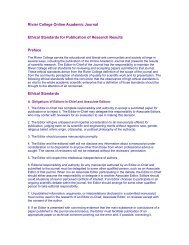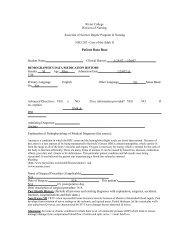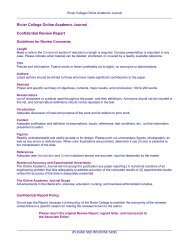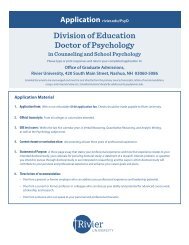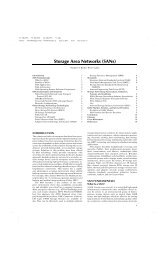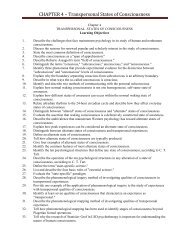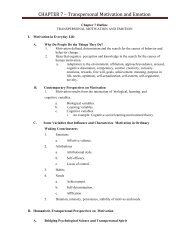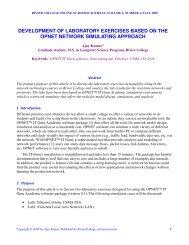methodologies and tools for the software quality ... - ResearchGate
methodologies and tools for the software quality ... - ResearchGate
methodologies and tools for the software quality ... - ResearchGate
You also want an ePaper? Increase the reach of your titles
YUMPU automatically turns print PDFs into web optimized ePapers that Google loves.
CCSC: Nor<strong>the</strong>astern Conference<br />
characteristics of object-oriented systems (properties of classes, polymorphism,<br />
encapsulation, inheritance, coupling, <strong>and</strong> cohesion) implemented in computer code<br />
written in C++ <strong>and</strong> Java. Their findings are summarized in Table 1 below.<br />
Metric<br />
Class Polymorphislatiotanclinsion<br />
Encapsu-<br />
Inheri-<br />
Coup-<br />
Cohe-<br />
Weighted Methods Per Class Yes Yes<br />
Response For Class Yes Yes<br />
Percentage of Public Data<br />
Yes<br />
Accesses to Public Data<br />
Yes<br />
Lack of Cohesion of Methods Yes Yes Yes<br />
Number of Children<br />
Yes<br />
Number of Parents<br />
Yes<br />
Depth in Inheritance Tree<br />
Yes<br />
Coupling Between Objects Yes Yes<br />
Attribute Hiding Factor Yes Yes<br />
Method Hiding Factor Yes Yes<br />
Polymorphism Factor Yes Yes<br />
Table 1. Clusters of Object-Oriented Metrics<br />
Students also identified some specific object-oriented metrics (Weighted Methods<br />
per Class, Response from a Class, Lack of Cohesion between Methods, <strong>and</strong> Coupling<br />
between Objects) that are <strong>the</strong> important factors <strong>for</strong> making a decision about <strong>the</strong> code<br />
module/class re-usability.<br />
3.4 Comparing Two Releases of <strong>the</strong> Code<br />
The last, fourth set of <strong>the</strong> lab <strong>and</strong> homework assignments was offered to students<br />
to identify major factors that <strong>for</strong>ced programmers to change <strong>the</strong> code [6] in <strong>the</strong> project<br />
redesign ef<strong>for</strong>ts. After analysis of <strong>the</strong> project <strong>software</strong> (about 300,000 lines of C-code)<br />
using <strong>the</strong> network-protocol approach 271 modules of <strong>the</strong> old Code Release 1.2 [6] were<br />
recommended <strong>for</strong> redesign. The re-engineering ef<strong>for</strong>ts resulted in <strong>the</strong> deletion of 16 old<br />
modules <strong>and</strong> in <strong>the</strong> addition of 7 new modules <strong>for</strong> <strong>the</strong> new Code Release 1.3. Analyzing<br />
<strong>the</strong> deleted modules, students found that 7 deleted modules were unreliable (v > 10) <strong>and</strong><br />
6 deleted modules were unmaintainable (ev > 4). Also, 19% of <strong>the</strong> deleted code was both<br />
unreliable <strong>and</strong> unmaintainable. Moreover, all seven new modules are reliable <strong>and</strong><br />
maintainable.<br />
After redesign, code changes resulted in <strong>the</strong> reduction of <strong>the</strong> code cyclomatic<br />
complexity by 115 units. 70 old modules (41% of <strong>the</strong> code) were improved, <strong>and</strong> only 12<br />
modules (about 7% of <strong>the</strong> code) deteriorated. This analysis demonstrates a robustness of<br />
<strong>the</strong> structured testing methodology <strong>and</strong> successful ef<strong>for</strong>ts in improving <strong>the</strong> <strong>quality</strong> of <strong>the</strong><br />
Code Releases. Studying <strong>the</strong> relationship between <strong>software</strong> defect corrections [6] <strong>and</strong><br />
cyclomatic complexity, students found a positive correlation between <strong>the</strong> numbers of<br />
possible errors, unreliable functions (with v > 10), <strong>and</strong> error submissions [6] from <strong>the</strong><br />
89




